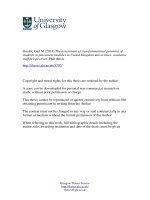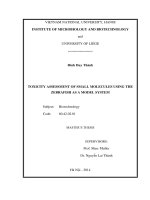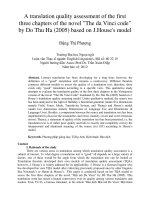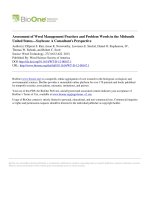Hydrogeomorphic Assessment of Beanblossom Bottoms Nature Preserve Sycamore Land Trust
Bạn đang xem bản rút gọn của tài liệu. Xem và tải ngay bản đầy đủ của tài liệu tại đây (340.9 KB, 10 trang )
Hydrogeomorphic Assessment
of Beanblossom Bottoms Nature Preserve
Sycamore Land Trust
Thuy Thi Hong An
SPEA E 440 – Wetlands
Fall 2011
1. Introduction
2. Methods
2.1 Site description
2.2 HGM assessment
3. Results and discussion
4. Conclusion
5. Literature cited
6. Figures and Tables
Thuy Thi Hong An
HGM Assessment
1. Introduction
We were asked by the Sycamore Land Trust, a local conservation organization, to
evaluate the wetland ecological functions of the Beanblossom Bottoms Nature Preserve. This
wetland had been converted from an agriculture site to gain wetland mitigation credits. The
Sycamore Land Trust is interested in selling these mitigation credits to INDOT to compensate
for the loss of wetlands caused by the construction of I – 69. Hydrogeomorphic (HGM)
approach was applied to calculate the mitigation ratio by evaluating wetland functions of the
mitigation site compared to the reference site.
2. Methods
2.1 Site description
The Beanblossom Bottoms Nature Preserve is a high quality hardwood wetland owned
by the Sycamore Land Trust. The latitude and longitude of this site are North 39 16.612 and
West 86 34.713 respectively (Cyberindiana 2011). The Beanblossom Bottoms Nature Preserve
used to be a farm land. According to the Soil survey of Monroe County, Indiana (1981), the soils
in the reference site are Zipp silty clay loam and Bonnie silt loam while the soil in the restored
site is Stendal silt loam (Figure 1). The mitigation site is marked by a star in Figure 2. The
reference site is the nearby forested wetland which has minimum disturbance.
2.2 HGM approach
The HGM classification system is based on three main criteria including landscape
position, water source, and hydrodynamics (Craft 2011). This approach was applied to evaluate
the functional indices of the mitigation wetland in comparing with the reference wetland of the
same type. Wetlands deliver a wide range of functions associated with four general categories:
Thuy Thi Hong An
HGM Assessment
Hydrology, biogeochemistry, plant habitat, and animal habitat (Hauer 1998). Therefore, it is
impossible to assess all functions. In this project, we evaluated only one function for each
category as following.
Table 1: Ecological functions evaluated in HGM method
No.
Category
Evaluated function
1
Hydrology
Long-term surface water storage
2
Biogeochemistry
Nutrient cycling
3
Plant habitat
Maintain characteristic plant communities
4
Animal habitat
Maintain spatial structure of habitat
Due to time limitation, only one sampling plot was established at the mitigation site and
a similar sampling plot was established at the reference site. Direct measurements were done
on-site while indirect measurements were estimated off-site. The detail information and results
are summarized in Table 3. The reference site was given a score of one for each index of
variable. The scores assigned for variables of the mitigation site were based on their likeness to
the reference site. The total function index was the average scores of the four functional
categories. The ratio of total function index of the reference site to the mitigation site is called
the HGM mitigation ratio. Because forested wetlands have a failure rate of 71%, an adjusted
HGM mitigation ratio is necessary (Robb 2002). The below equation is used to calculate the
adjusted HGM mitigation ratio.
Adjusted HGM mitigation ratio =
HGM mitigation ratio
Success rate
In the case of forested wetlands, the success rate is 29% or 0.29 (Robb 2002).
Thuy Thi Hong An
HGM Assessment
3. Results and discussion
The overall results are shown in Table 2. Comparing to the reference standard, the
mitigation site had the long-term surface water storage score of 0.75. Therefore, it can provide
about 75% of ecological functions related to long-term surface water storage delivered by the
reference site. This result is logical since the mitigation site is adjacent to the reference site
accounting for their similar macrotopography. The nutrient cycling score of the restored site
was only 0.1 proving that the restored site was not good at providing biogeochemical functions.
The scores for maintaining characteristic plant community and spatial structure of habitat were
0.51 and 0.52 respectively. In other words, the mitigation wetland can deliver a half level of
functions as plant and animal habitats compared to those provided by the reference wetland.
Table 2: Index of variables for reference site and mitigation site
at Beanblossom Bottoms Nature Preserve
Wetland functions
Index of variable
Reference site
Mitigation site
Long-term surface water storage
1
0.75
Nutrient cycling
1
0.1
Maintain characteristic plant communities
1
0.51
Maintain spatial structure of habitat
1
0.52
1
0.47
Total function index
Mitigation ratio
Failure adjusted mitigation ratio
1 : 0.47 = 2.13 : 1
(2.13/0.29) : 1 = 7.34 : 1
The total function index based on the above four wetland ecological functions was 0.47.
It means that the mitigation site can perform about 47% of ecological functions provided by the
reference site. The mitigation ratio was 2.13 indicating that we need 2.13 hectares of mitigation
Thuy Thi Hong An
HGM Assessment
wetlands to deliver the same level of functions provided by 1 hectare of reference wetlands.
Due to a failure rate of 71% for forested wetlands, 7.34 hectares of constructed forest wetland
was recommended to compensate for the loss of 1 hectare of natural forested wetland.
4. Conclusion
Sycamore Land Trust should proceed with creating the mitigation bank to sell mitigation
credits for INDOT. The recommended scale is 2.13 : 1 which means that 2.13 hectares of the
mitigation wetland is needed to replace 1 hectare of the natural wetland destroyed. However, a
mitigation ratio of 7.34 : 1 could be applied to ensure higher successful mitigation.
Thuy Thi Hong An
HGM Assessment
5. Literature cited
1. Craft, Christopher B. (2011). Wetlands: Biology and Regulation. Classpak Publishing.
Indiana University.
2. Hauer, F. R. and R. D. Smith (1998). "The hydrogeomorphic approach to functional
assessment of riparian wetlands: evaluating impacts and mitigation on river floodplains in the
U.S.A." Freshwater Biology 40(3): 517-530.
3. Robb, J. T. (2002). "Assessing wetland compensatory mitigation sites to aid in
establishing mitigation ratios." Wetlands 22(2): 435-440.
4. Soil survey of Monroe County, Indiana. 1981. Soil Conservation Service, U. S.
Department of Agriculture.
5. U.S. Department of Agriculture. Natural Resources Conservation Service.
Last accessed December 6th, 2011
6. Syscamore Land Trust.
Last accessed December 6th, 2011
7. Cyberindiana
/>Last accessed December 6th, 2011
Thuy Thi Hong An
HGM Assessment
6. Figures and Tables
Figure 1: Soil surveys at Beanblossom Bottoms Nature Preserve
Data from US Department of Agriculture Natural Resources Conservation Service November, 2011
Thuy Thi Hong An
HGM Assessment
Figure 2: Sycamore Land Trust property boundaries for the Beanblossom Bottoms Nature Preserve, Monroe County, IN
(After Sycamore Land Trust Website, accessed on December 5th, 2011)
Thuy Thi Hong An
HGM Assessment
Table 3: Summary of values and calculation for wetland functions using hydrogeomorphic index
at Beanblossom Bottoms Nature Preserve, Sycomore Land Trust (Data collected on December 2nd, 2011)
Model Measure
VSURWAT
VMACRO
Indicators of
surface water
present
Macrotopographic
relief
VPROD
Aerial net primary
productivity
VTURNOV
Annual turnover
of detritus
VCOMP
Species
composition for
tree (T), sapling
(SAP), shrub (S),
and ground cover
(GC) strata
VREGEN
Seedlings/saplings
and/or clonal
shoots
Measure
Reference Wetland
LONG-TERM SURFACE WATER STORAGE
~30.5 cm flooding observed from
Visual observation of water
watermarks, buttressing and moss on
mark, buttress, moss
trees
Estimated by viewing aerial Uniformly flat
photograph (Google earth)
Minor elevation changes (dead trees)
NUTRIENT CYCLING
Index of
Variable
Restored Wetland
Index of
Variable
1.0
~ 15.25 cm flooding
observed from watermarks
on trees
0.5
1.0
Uniformly flat
1.0
Index of Function = (VSurfacewater + VMacro)/2
0.75
9 cm
6 cm
Determined by measuring
1.0
6 cm = 7.8 cm average
= 6.0 cm average
thickness of leaf litter layer
10 cm (130% calculated)
8 cm
No observable organic A
Determined by measuring
Very thin organic layer if present
horizon
the thickness of A
< 1.0 cm of darker organic matter at
1.0
Larger chunks of organic
horizontal layer
the top of the soil sample
matter (leaf litter) than
reference site
Index of Function If VAerial NPP > VTurnover then index is VTurnover otherwise use V Aerial NPP
MAINTAIN CHARACTERISTIC PLANT COMMUNITY
T: Fraxinus pennsylvanica,
Platanus occidentalis, Acer
Determined 3 dominant
T: Fraxinus pennsylvanica, Quercus
rubrum [1]
species for each strata.
bicolor, Quercus palustris
SAP: Acer rubrum, Platanus
Plot size:
occidentalis, Quercus alba
Trees >5cm DBH in 10 m
SAP: Acer rubrum, Fraxinus
[1]
1.0
radius
pennsylvannica
S: None
Saplings/shrubs in 5 m
S: None
GC: Boehmeria cylindrical,
radius
GC: Boehmeria cylindrical, Misc
Misc Sedge, Misc Poacea
Herbaceous in 2 m radius
Sedge, Misc Poacea spp.
spp., Lysimachia
nummularia [3]
6 cm
7 cm
6 cm
5 cm
6 cm
Estimated ratio of seedlings
to saplings (DBH<5 cm)
1:10
1.0
1:20
0.5
0.1
0.1
0.25
0.5
Thuy Thi Hong An
VCANOPY
Canopy cover
VDTREE
Tree Density
VBTREE
VSNAGS
VMATUR
VSTRATA
VPATCH
VGAPS
Tree basal area
Density of
standing dead
trees
Abundance of
very mature trees
Number and
attributes of
vertical strata of
vegetation
Vegetation
patchiness
Gaps in forest
Visual estimation of 10 m
radius on site
Count # trees (>5 cm DBH)
in 10 m radius
HGM Assessment
T: 90%
1.0
T: 80%
1
60
1.0
180
0.1
Acer rubrum- 16 22 20 18
14 16 18 30 16 20
Fraxinus pennsylvanica- 20
13 10 15 15 20 10 10 18
Measured DBH in a 10 m
Platanus occidentalis- 28 13
radius plot for all tree
28 18 27 25 28 32 47 40 34
1.0
species > 5 cm DBH using a
20 35 32 15 20 22 20 20 21
standard DBH tape
29
Populus deltoides- 99
Quercus palustris- 35 32 30
15
Total = 3295
Total = 1086 (33%)
Index of Function = [(VComposition + VRegeneration + VCanopry Cover) + (VTree Density + VBasal Area)/2] /4
MAINTAIN SPATIAL STRUCTURE OF HABITAT
Acer rubrum- 28 33 15 13 19 25 27 28
30 31 30 16 24
Fraxinus pennsylvanica- 83 74 117 90
80 100 25 75 116 84 42 27 80 65 85
59 16 75 69 70 83 84 75 65
Quercus spp- 134 96 78 80 90 65 79
82 77 68 83
Ulmus Americana- 29 30 35 42 40 30
27 39 33
0.5
0.51
Counted standing dead
trees in 10 m radius plot
10
1.0
0
0
Counted very mature trees
as far as able to view
24
1.0
2
0.1
Estimated number of strata
and their percent coverage
Trees: 90%
Saplings: 80%
Shrubs: 10%
Ground cover: 30%
1.0
80%
0%
0%
100%
0.5
Appeared uniform
1.0
Appeared uniform
1
Appeared uniform
1.0
Appeared uniform
1
Viewed aerial photograph
using Google Earth
Viewed aerial photograph
using Google Earth
Index of Function = (VSnags + VMature Trees + VStrata + VPatch + VGaps) /5
Total function index
Mitigation ratio
Failure adjusted mitigation ratio
0.52
0.47
2.13 : 1
7.34 : 1









